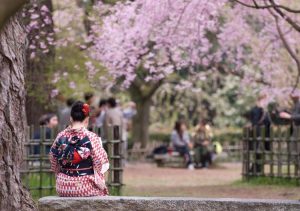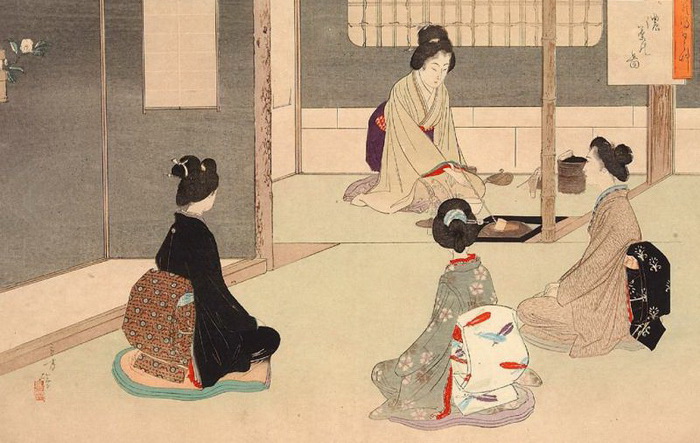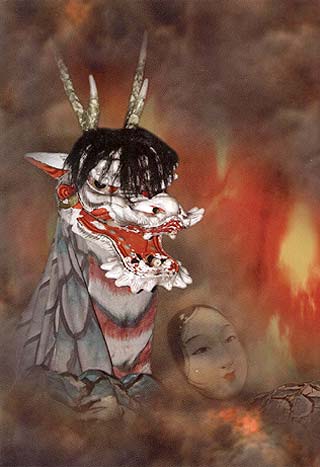Mores in Japan
 If it’s good, one isn’t enough, and if it’s bad, two are enough.
If it’s good, one isn’t enough, and if it’s bad, two are enough.
The first man and first woman, in the understanding of the Japanese, is the god Idaanami and the goddess Izanami. It is not known how they were born. But the touching dialogue following this is known. Izanangi: “How is your body made?” Izanami: “My body grew, grew, but there is a place that never grew.” Izanangi: “My body grew and grew, but there is a place that has grown too much. Therefore, I think, I have a place on my body that has grown too much, put in a place that you haven’t grown on your body, and give birth to a country. Well how shall we give birth? ” Izanami: “That’ll be fine.” So the islands of the Japanese archipelago appeared.
It is interesting that the earth is not created by a single Creator (as in the Christian tradition), but by two deities, and their combination is not perceived as something sinful. Therefore, the whole subsequent history of the relationship between a man and a woman does not carry a racket of hypocrisy in Japan, and the Japanese religion – Shintoism – never knew the institution of monasticism.
The relationship between a man and a woman was determined by a special code of conduct. Hearing that there was a girl in some family, who was pretty and skillful in writing poetry, the man sent her a message in which the poems were bound to be contained. They expressed praise for her beauty, as well as impatience about the upcoming date. The girl usually answered that she did not believe in the sincerity of her correspondent, known for his frivolity. After withstanding the decency period of languor, she finally agreed to a date, which was very peculiar: the man and woman talked, separated by a curtain that encloses the woman’s inner chambers.
So there was no question of any “love at first sight”. But it was possible to fall in love “from the first word” – only after hearing a voice. After the participants in the meeting made sure of mutual friendliness, the man spent the night in the house of his chosen one, and returned home early in the morning, without fail leaving a poetic message. If expectations were not deceived, then he came for the second and third time. And a few days later, a meal was arranged in the bride’s house, during which the bride’s parents first saw the groom. After this, the marriage was considered to be concluded, and the husband received the right not to return to his house in the morning.
There were many windy men among the Heian aristocrats, and many of them left their wife (no divorce proceedings were provided for), without having lived with her for a month. During the son-in-law’s rare visits, his wife’s parents slept holding his shoes in their hands — with the help of this magical means they tried to hold on to their daughter’s husband.
Polygamy was completely legalized. But this was not at all like a Middle Eastern or Ancient Chinese harem with female squabbles, when the ladies were kept together under the supervision of an almighty eunuch. Each of the wives (or lovers) of the Japanese lived in their own home. The husband visited them only at night, and women did not necessarily know about each other’s existence. Aristocrats joked that no matter how good the wife, one is clearly not enough, but if it’s bad, then two will be enough. Women, however, also had great freedom of choice. Otherwise, to whom then could men travel at night?
The matter, however, changes with the coming to power of the military estate – the samurai. Now a woman is considered in two guises: as an object of sexual pleasure (brothels appear) and as a fold necessary for procreation. A very strict code of conduct for a woman is also being developed, which is strongly recommended not to lose control over herself even in a dream: one should sleep lying on his back with legs folded together and arms extended along the body.
Etiquette of female behavior has not disappeared even today. For a European brought up on the misunderstood ideas of gender equality, as a result of which a woman becomes like a man (short haircut, pants), and a man looks like a woman (long hairstyle, earrings), the Japanese woman makes the most favorable impression. One enthusiastic traveler once remarked: “Combine the light look of the sister of mercy and the heart of an unspoiled child – and you get an idea of a Japanese woman!”
When talking to a man, a Japanese woman should always smile warmly. Sometimes, however, this leads to an annoying misunderstanding. For example, when I first found myself in Japan, my kind Japanese friend began to talk once about the circumstances of the death of her brother, who had a car accident. At the same time, she smiled sweetly. I took it for spiritual callousness, and only then I realized that the rules of decency oblige her to show a smile under any circumstances.
The statistics of interethnic marriages is interesting: Europeans are happy to marry well-mannered, smiling, trained in housekeeping and rarely scolding Japanese women for their husbands. Yes, and those, it should be noted, are not caressed in their home country by any signs of attention (like “Lady’s first” at the door or caring for a female orgasm in bed), they are happy to respond to the offer.




